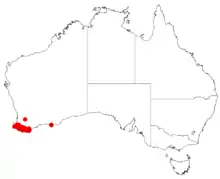| Acacia hastulata | |
|---|---|
_(8203269260).jpg.webp) | |
| Illustration of Acacia hastulata | |
| Scientific classification | |
| Kingdom: | Plantae |
| Clade: | Tracheophytes |
| Clade: | Angiosperms |
| Clade: | Eudicots |
| Clade: | Rosids |
| Order: | Fabales |
| Family: | Fabaceae |
| Subfamily: | Caesalpinioideae |
| Clade: | Mimosoid clade |
| Genus: | Acacia |
| Species: | A. hastulata |
| Binomial name | |
| Acacia hastulata | |
 | |
| Occurrence data from AVH | |
Acacia hastulata is a shrub belonging to the genus Acacia and the subgenus Phyllodineae that is endemic to an area in south western Australia.
Description
The slender, spreading and prickly shrub typically grows to a height of 0.3 to 2.0 metres (1 to 7 ft)[1] and usually has an intricate habit. It has long and thin red to orange brown coloured branchlets that are straight or arch downwards and are sparsely to moderately covered with soft long hairs and have setaceous to narrowly triangular stipules with a length of 2.5 to 4 mm (0.098 to 0.157 in). Like most species of Acacia it has phyllodes rather than true leaves. The crowded, patent and evergreen phyllodes have a narrow triangular shape resembling a spearhead and taper to a sharp point. The pungent and slender phyllodes are 3.5 to 6 mm (0.14 to 0.24 in) in length and have a width of 2 to 3 mm (0.079 to 0.118 in). They are glabrous and rigid and have a prominent central midrib.[2] It produces cream-yellow flowers from July to November.[1] The simple inflorescences occur singly in the axils on glabrous stalks with a length of 2 to 4 mm (0.079 to 0.157 in). The spherical flower-heads contain three to five creamy yellow coloured flowers. Following flowering red-brown striated seed pods form. The subglabrous and curved pods are terete and narrowed at both ends with a length of up to 5.5 cm (2.2 in) and a diameter of 1.5 to 2 mm (0.059 to 0.079 in). The seeds inside have an oblong to slightly elliptic shape with a length of 2.5 to 3.5 mm (0.098 to 0.138 in) and have a terminal aril.[2]
Taxonomy
The species was first formally described by the botanist James Edward Smith in 1818 as part of the Abraham Rees work The Cyclopaedia. It was reclassified as Racosperma hastulatum by Leslie Pedley in 2003 then transferred back to genus Acacia in 2014.[3] It belongs to the Acacia horridula group but is easily distinguished by the shape of its phyllodes. The type specimen was collected from around King George Sound by Archibald Menzies[2] as part of the Vancouver Expedition.
Distribution
It is native to an area along the south coast in the Goldfields-Esperance, Great Southern and South West regions of Western Australia where it is commonly situated along watercourses and swampy areas.[1] The bulk of the population is found from south of Nannup and the Scott River in the west to around Albany in the east with an isolated population found much further east around Esperance where it is found in forests that also usually contain species of Melaleuca or Banksia and is also located within karri forest communities.[2]
See also
References
- 1 2 3 "Acacia hastulata". FloraBase. Western Australian Government Department of Biodiversity, Conservation and Attractions.
- 1 2 3 4 "Acacia hastulata". WorldWideWattle. Western Australian Herbarium. Retrieved 22 April 2020.
- ↑ "Acacia hastulata Sm". Atlas of Living Australia. Global Biodiversity Information Facility. Retrieved 22 April 2020.